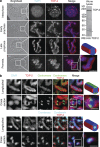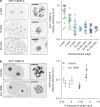CENP-A and topoisomerase-II antagonistically affect chromosome length
- PMID: 28733327
- PMCID: PMC5584148
- DOI: 10.1083/jcb.201608084
CENP-A and topoisomerase-II antagonistically affect chromosome length
Abstract
The size of mitotic chromosomes is coordinated with cell size in a manner dependent on nuclear trafficking. In this study, we conducted an RNA interference screen of the Caenorhabditis elegans nucleome in a strain carrying an exceptionally long chromosome and identified the centromere-specific histone H3 variant CENP-A and the DNA decatenizing enzyme topoisomerase-II (topo-II) as candidate modulators of chromosome size. In the holocentric organism C. elegans, CENP-A is positioned periodically along the entire length of chromosomes, and in mitosis, these genomic regions come together linearly to form the base of kinetochores. We show that CENP-A protein levels decreased through development coinciding with chromosome-size scaling. Partial loss of CENP-A protein resulted in shorter mitotic chromosomes, consistent with a role in setting chromosome length. Conversely, topo-II levels were unchanged through early development, and partial topo-II depletion led to longer chromosomes. Topo-II localized to the perimeter of mitotic chromosomes, excluded from the centromere regions, and depletion of topo-II did not change CENP-A levels. We propose that self-assembly of centromeric chromatin into an extended linear array promotes elongation of the chromosome, whereas topo-II promotes chromosome-length shortening.
© 2017 Ladouceur et al.
Figures





References
Publication types
MeSH terms
Substances
Grants and funding
LinkOut - more resources
Full Text Sources
Other Literature Sources

